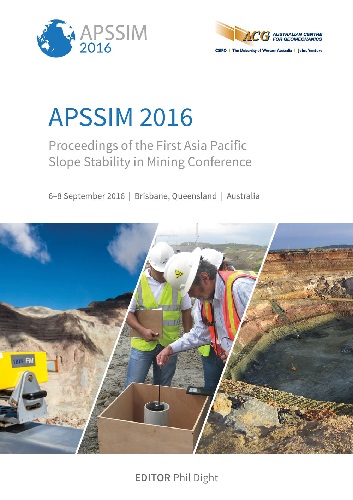Unconventional methods to treat geotechnical uncertainty in slope design

|
Authors: Contreras, LF; Ruest, M |
DOI https://doi.org/10.36487/ACG_rep/1604_17_Contreras
Cite As:
Contreras, LF & Ruest, M 2016, 'Unconventional methods to treat geotechnical uncertainty in slope design', in PM Dight (ed.), APSSIM 2016: Proceedings of the First Asia Pacific Slope Stability in Mining Conference, Australian Centre for Geomechanics, Perth, pp. 315-330, https://doi.org/10.36487/ACG_rep/1604_17_Contreras
Abstract:
The definition of the geotechnical model for slope design is based on the geological, structural, rock mass and hydrogeological models. Each model is described by different sets of information and parameters and is defined at a scale of interest for the purpose of the analysis of slope behaviour. However, no clear guidelines exist in terms of the appropriate statistical methods to manage this information. Probabilistic methods are traditionally used to account for the uncertainty in engineering design, however, the base assumptions of these methods are not always fully understood, resulting in misinterpretations of results. There are two main approaches of statistical analysis known as frequentist (classical) and Bayesian, which are based on different interpretations of probability. In the classical approach, probabilities are considered as frequencies in a series of similar trials, whereas in the Bayesian approach, probabilities correspond to degrees of belief. One of the main characteristics of the Bayesian approach is that makes use of both prior information on the hypothesis (or model) being examined and the likelihood of the available data, to provide a balanced answer to the probability of that hypothesis (or model). Another aspect of the uncertainty characterisation process is the understanding of the type of uncertainty present in the various components of the geotechnical model. At a broad level there are two main types of uncertainty in geotechnical engineering, one due to random variation of the aspect evaluated (aleatory) and the second due to lack of knowledge of the subject under analysis (epistemic). The uncertainty is considered epistemic if it can be reduced with the collection of additional data or by refining models, otherwise it is treated as natural variation. The majority of the uncertainty in the geotechnical model for slope design is epistemic, typically analysed with probabilistic methods. However, epistemic uncertainty has different aspects some of which (i.e. vagueness or non specificity) can be represented more naturally with alternative approaches outside the field of probability (i.e. interval analysis, possibility and evidence theories). Simple examples will be included to illustrate the merits of treating uncertainty in the mine slope design process with unconventional methods such as Bayesian statistics and non-probabilistic based approaches.
Keywords: uncertainty, probabilistic methods, Bayesian statistics, epistemic uncertainty
References:
Baecher, GB & Christian, JT 2003, Reliability and statistics in geotechnical engineering, Wiley, Chichester, UK.
Bedi, A & Harrison, JP 2013, ‘A comparison of Bayesian techniques and non-probabilistic models in rock engineering design, in 47th US Rock Mechanics/Geomechanics Symposium, A.R.M. Association, San Francisco, ELSEVIER: 10.
Blockley, D 2013, ‘Analysing uncertainties: Towards comparing Bayesian and interval probabilities', Mechanical Systems and Signal Processing 37 (1–2), pp. 30–42.
Christian, JT 2003, ‘Geotechnical Engineering Reliability: How Well Do We Know What We Are Doing?, Journal of Geotechnical and Geoenvironmental Engineering, vol. 130, no. 10.
Dubois, D & Prade, H 2009, ‘Possibility Theory’, in RA Meyers (ed.), Encyclopedia of Complexity and Systems Science, Springer, pp. 6927–6939.
Feng, X & Jimenez, R 2015, ‘Estimation of deformation modulus of rock masses based on Bayesian model selection and Bayesian updating approach’, Engineering Geology, 199, pp. 19–27.
Foreman-Mackey, D, Hogg, DW, Lang, D & Goodman, J 2013, ‘emcee: The MCMC Hammer’, Publications of the Astronomical Society of Pacific, vol. 125, no. 925, pp. 306–312.
Halpern, JY & Fagin, R 1992, ‘Two views of belief: belief as a generalized probability and belief as evidence’, Artificial Intelligence, vol. 54, no. 3, pp. 275–317.
Helton, JC & Sallaberry, CJ 2008, Alternative Representations of Uncertainty, viewed 20 January 2016,
Helton, JC, Johnson, JD & Oberkampf, WL 2004, ‘An exploration of alternative approaches to the representation of uncertainty in model predictions’, Reliability Engineering & System Safety, 85(1–3), pp. 39–71.
Hoek, E 2006, Practical Rock Engineering, course notes on rock mass properties, viewed 20 January 2016,
Hoek, E, Carter, TG & Diederichs, MS 2013, ‘Quantification of the Geological Strength Index Chart’, American Rock Mechanics Association.
Klir, GJ 1989, ‘Is there more to uncertainty than some probability theorists might have us believe’, International Journal of General Systems, 15(4), pp. 347–378.
Klir, GJ 2004, ‘Generalized information theory: aims, results, and open problems’, Reliability Engineering and System Safety, 85(1), pp. 21–38.
Klir, GJ & Wierman, MJ 1999, Uncertainty-Based Information: Elements of Generalized Information Theory, Physica-Verlag HD.
Kruschke, JK 2014, Doing Bayesian Data Analysis: A Tutorial with R, JAGS and STAN, Academic Press/Elsevier.
Moore, RE, Kearfott, RB & Cloud, MJ 2009, Introduction to Interval Analysis, Society for Industrial and Applied Mathematics, Philadelphia.
Perras, MA & Diederichs, MS 2014, ‘A Review of the Tensile Strength of Rocks: Concepts and Testing’, Geotechnical and Geological Engineering, vol. 32, no. 2, pp. 525–546.
Stacey, P 2009, ‘Fundamentals of Slope Design’, in J Read and P Stacey (eds), Guidelines for Open Pit Slope Design, CSIRO Publishing, Collingwood, pp. 1–14.
VanderPlas, J 2014, Frequentism and Bayesianism: A Practical Introduction, in Phytonic Preambulations Blog, viewed 20 January 2015,
Wang, Y & Aladejare, AE 2015 ‘Selection of site-specific regression model for characterization of uniaxial compressive strength of rock’, International Journal of Rock Mechanics and Mining Sciences, 75, pp. 73–81.
Zhang, LL, Zhang, J, Zhang, LM & Tang, WH 2010, ‘Back analysis of slope failure with Markov chain Monte Carlo simulation’, Computers and Geotechnics, 37(7–8), pp. 905–912.
Zimmermann, HJ 2000, ‘An application-oriented view of modelling uncertainty’, European Journal of Operational Research, 122(2), pp. 190–198.
© Copyright 2025, Australian Centre for Geomechanics (ACG), The University of Western Australia. All rights reserved.
View copyright/legal information
Please direct any queries or error reports to repository-acg@uwa.edu.au
View copyright/legal information
Please direct any queries or error reports to repository-acg@uwa.edu.au